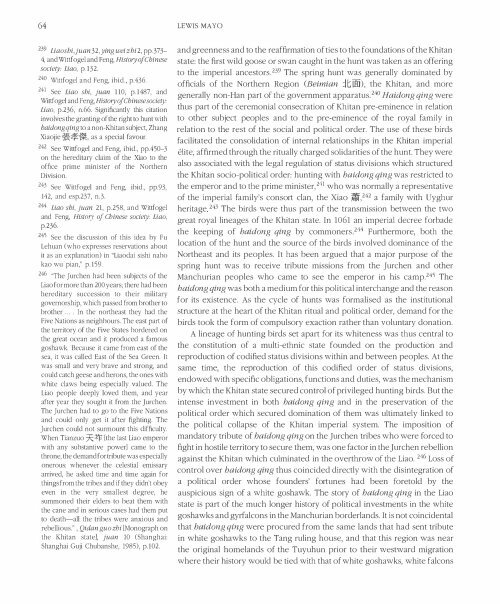East Asian History - ANU
East Asian History - ANU
East Asian History - ANU
- No tags were found...
Create successful ePaper yourself
Turn your PDF publications into a flip-book with our unique Google optimized e-Paper software.
64LEWIS MAYO239 Liao shi,juan 32, ying wei zhi 2, pp.373-4, and Wittfogel and Feng, <strong>History</strong> of Chinesesociety: Liao, p.132.240 Wittfogel and Feng, ibid., p.436.241 See Liao shi, juan 110, p.1487, andWittfogel and Feng, <strong>History</strong>of Chinese society:Liao, p.236, n.66. Significantly this citationinvolves the granting of the right to hunt withhaidong qing to a non-Khitan subject, ZhangXiaojie 13'IE, as a special favour.242 See Wittfogel and Feng, ibid., pp.450-3on the hereditary claim of the Xiao to theoffice prime minister of the NorthernDivision.243 See Wittfogel and Feng, ibid., pp.93,142, and esp.237, n.3.244 Liao shi, juan 21, p.258, and Wittfogeland Feng, Histmy of Chinese society: Liao,p.236.245 See the discussion of this idea by FuLehuan (who expresses reservations aboutit as an explanation) in "Liaodai sishi nabokao wu pian," p.159.246 "The Jurchen had been subjects of theLiao for more than 200 years; there had beenhereditary succession to their militarygovernorship, which passed from brother tobrother ... . In the northeast they had theFive Nations as neighbours. The east part ofthe territory of the Five States bordered onthe great ocean and it produced a famousgosha wk. Beca use it came from east of thesea, it was called <strong>East</strong> of the Sea Green. Itwas small and very brave and strong, andcould catch geese and herons, the ones withwhite claws being especially valued. TheLiao people deeply loved them, and yearafter year they sought it from the Jurchen.The Jurchen had to go to the Five Nationsand could only get it after fighting. TheJurchen could not surmount this difficulty.When TianZllo J(rF [the last Liao emperorwith any substantive powerl came to thethrone, the demand for tribute was especiallyonerous: whenever the celestial emissaryarrived, he asked time and time again forthings from the tribes and if they didn't obeyeven in the very smallest degree, hesummoned their elders to beat them withthe cane and in serious cases had them putto death-all the tribes were anxious andrebellious." , Qidanguozhi [Monograph onthe Khitan state], juan 10 (Shanghai:Shanghai Guji Chubanshe, 1985), p.102.and greenness and to the reaffirmation of ties to the foundations of the Khitanstate: the first wild goose or swan caught in the hunt was taken as an offeringto the imperial ancestors.239 The spring hunt was generally dominated byofficials of the Northern Region (Beimian :ltOO) 'the Khitan, and moregenerally non-Han part of the government apparatus. 240 Haidong qing werethus part of the ceremonial consecration of Khitan pre-eminence in relationto other subject peoples and to the pre-eminence of the royal family inrelation to the rest of the social and political order. The use of these birdsfacilitated the consolidation of internal relationships in the Khitan imperialelite, affirmed through the ritually charged solidarities of the hunt. They werealso associated with the legal regulation of status divisions which structuredthe Khitan socio-political order: hunting with haidong qing was restricted tothe emperor and to the prime minister,241 who was normally a representativeof the imperial family's consort clan, the Xiao .,242 a family with Uyghurheritage 243 The birds were thus part of the transmission between the twogreat royal lineages of the Khitan state. In 1061 an imperial decree forbadethe keeping of haidong qing by commoners.244 Furthermore, both thelocation of the hunt and the source of the birds involved dominance of theNortheast and its peoples. It has been argued that a major purpose of thespring hunt was to receive tribute missions from the Jurchen and otherManchurian peoples who came to see the emperor in his camp.245 Thehaidong qing was both a medium for this political interchange and the reasonfor its existence. As the cycle of hunts was formalised as the institutionalstructure at the heart of the Khitan ritual and political order, demand for thebirds took the form of compulsory exaction rather than voluntary donation.A lineage of hunting birds set apart for its whiteness was thus central tothe constitution of a multi-ethnic state founded on the production andreproduction of codified status divisions within and between peoples. At thesame time, the reproduction of this codified order of status divisions,endowed with specific obligations, functions and duties, was the mechanismby which the Khitan state secured control of privileged hunting birds. But theintense investment in both haidong qing and in the preservation of thepolitical order which secured domination of them was ultimately linked tothe political collapse of the Khitan imperial system. The imposition ofmandatory tribute of haidong qing on the Jurchen tribes who were forced tofight in hostile territory to secure them, was one factor in the Jurchen rebellionagainst the Khitan which culminated in the overthrow of the Liao. 246 Loss ofcontrol over haidong qing thus coincided directly with the disintegration ofa political order whose founders' fortunes had been foretold by theauspicious sign of a white goshawk. The story of haidong qing in the Liaostate is part of the much longer history of political investments in the whitegoshawks and gyrfalcons in the Manchurian borderlands. It is not coincidentalthat haidong qing were procured from the same lands that had sent tributein white goshawks to the Tang ruling house, and that this region was nearthe original homelands of the Tuyuhun prior to their westward migrationwhere their history would be tied with that of white goshawks, white falcons
















